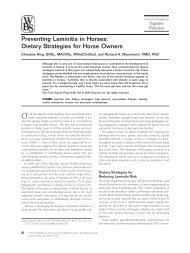Nutritional Secondary Hyperparathyroidism in the Horse
Nutritional Secondary Hyperparathyroidism in the Horse
Nutritional Secondary Hyperparathyroidism in the Horse
Create successful ePaper yourself
Turn your PDF publications into a flip-book with our unique Google optimized e-Paper software.
62 Expcrimcntal <strong>Nutritional</strong> <strong>Secondary</strong> I-Jypcrparathyroiclism <strong>in</strong> <strong>the</strong> <strong>Horse</strong><br />
7'a0/(' /YAY]. Weight <strong>in</strong>crease of upper parathyroid glands <strong>in</strong> relation to ccllular<br />
hypertrophy<br />
I-lorsc Relative weight Volumetric <strong>in</strong>crease<br />
of parathyroids due to hypertrophy<br />
NSI-I 1 2.14 u C 1.99 x c<br />
NSM 2 5.44 x c 2.37 > C<br />
NSII 3 2.88 / C 2.58 ,-' C<br />
(:olltrol (1 c<br />
There was, <strong>the</strong>refore, an actual <strong>in</strong>crease <strong>in</strong> parenchymatous tissue. It<br />
has already been demonstrated that <strong>the</strong> light chief cells were hyper-<br />
trophic. Wheter or not this hypertrophy alone can expla<strong>in</strong> <strong>the</strong> enlarge-<br />
ment of <strong>the</strong> glands must now be considered. Table XXI shows how<br />
many times greater <strong>the</strong> relative parathyroid weights were <strong>in</strong> NSH<br />
horses than <strong>in</strong> <strong>the</strong> control. The volumetric <strong>in</strong>crease due to hypertrophq<br />
is expressed <strong>in</strong> <strong>the</strong> same way. The figures of <strong>the</strong> volumes were obta<strong>in</strong>ed<br />
by multiply<strong>in</strong>g <strong>the</strong> figure of <strong>the</strong> nuclear surface by a factor r3/+ ( = r,<br />
<strong>the</strong> mean radius of <strong>the</strong> nucleus). Thus Table XXI shows that <strong>the</strong> hyper-<br />
trophy alone cannot expla<strong>in</strong> <strong>the</strong> enlargement of <strong>the</strong> glands. It was<br />
<strong>the</strong>refore concluded that a hyperplasia of <strong>the</strong> parathyroid glands was<br />
also present <strong>in</strong> <strong>the</strong> NSI-I horses.<br />
f*g. 27. (.ontrol. : 45.<br />
Fiq. 29. NSI-I 1. Alandihlc. Ostcitis tibrosa. Ostcoclasts <strong>in</strong> Howship's lacunae<br />
(straight arrow) or flattened along <strong>the</strong> bone. Ostcoblastic apposition on opposite<br />
side of trabccu.lac (untilled arrow). Poorly collagcnized fibrous tissue replac<strong>in</strong>g<br />
rcsorbcd bone. 14 & G. r 120.<br />
F;,y, 30. NSH 1. hlasilla. Osteitis tihrosa. All old bone rcsorhcd. Onc largc<br />
ostcoclast with pyknotic nuclci left (arrow). Vivid ostcoblastic activity with<br />
abundant nontn<strong>in</strong>cr.alizcd ostcoid. Fibrous tissue replac<strong>in</strong>g rcsorhcd bone. I4 ct E,<br />
Y 250.<br />
Downloaded from<br />
vet.sagepub.com by guest on April 14, 2010



